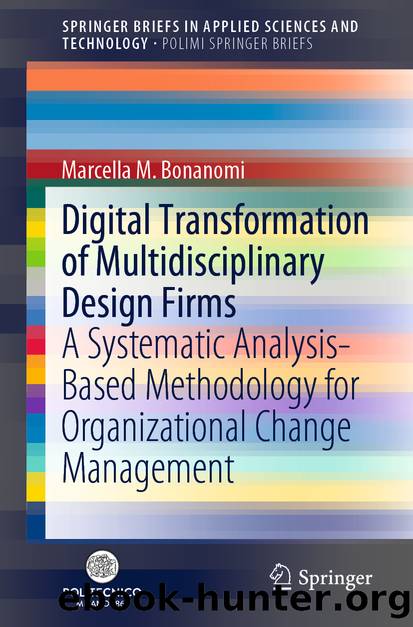Digital Transformation of Multidisciplinary Design Firms by Marcella M. Bonanomi

Author:Marcella M. Bonanomi
Language: eng
Format: epub
ISBN: 9783030197018
Publisher: Springer International Publishing
The ‘little bim’ perspective refers to BIM as a ‘tool’. In this case, the acronym stands for Building Information Model, and it therefore describes BIM as a ‘tool’ to develop data-rich parametric models.
Considering these two different perspectives about the definition of BIM, Jernigan (2007) couples them together and defines BIM as: “A set of interacting policies, processes, and technologies generating a methodology to manage the essential building design and project data in digital format throughout the building’s life-cycle.” Many other researchers suggest that BIM has a multidimensional nature. Succar (2013), for example, proposes a multidimensional definition of BIM: “A set of technologies, processes, and policies enabling multiple stakeholders to collaboratively design, construct, and operate a facility.” In addition to the ‘process’ and ‘technology’ perspectives, many researchers emphasize the human dimension of BIM (Reddy 2011; Succar and Kassem 2015): “BIM is about people and process as much as it is about technology” (Specialist Engineering Contractors Group 2013). Authors’ belief is that a successful digital transformation requires a balance between technology, organization, and process. Furthermore, they underline the importance of cross-combining these dimensions of change with a full understanding of the context of change, as well as the stage of implementation.
All these studies argue that there are various dimensions to consider in order to implement a firm’s digital transformation. Given this point of departure, we argue that a firm’s digital transformation should be implemented by managing the 4Ps lenses of change: Process, People, Product, and Policy. This translates into organizational change management that does not only focus on the new technological infrastructure—in terms of software and tools—but also on redesigning processes according to the new paradigms of collaboration and iteration, as well as reconfiguring the existing organizational structure in order to shift toward a platform-based and networked organization.
Download
This site does not store any files on its server. We only index and link to content provided by other sites. Please contact the content providers to delete copyright contents if any and email us, we'll remove relevant links or contents immediately.
Hit Refresh by Satya Nadella(9038)
The Compound Effect by Darren Hardy(8808)
Change Your Questions, Change Your Life by Marilee Adams(7634)
Nudge - Improving Decisions about Health, Wealth, and Happiness by Thaler Sunstein(7615)
The Black Swan by Nassim Nicholas Taleb(7010)
Deep Work by Cal Newport(6877)
Daring Greatly by Brene Brown(6444)
Rich Dad Poor Dad by Robert T. Kiyosaki(6399)
Principles: Life and Work by Ray Dalio(6206)
Man-made Catastrophes and Risk Information Concealment by Dmitry Chernov & Didier Sornette(5921)
Playing to Win_ How Strategy Really Works by A.G. Lafley & Roger L. Martin(5914)
Digital Minimalism by Cal Newport;(5662)
Big Magic: Creative Living Beyond Fear by Elizabeth Gilbert(5610)
The Myth of the Strong Leader by Archie Brown(5424)
The Slight Edge by Jeff Olson(5346)
Discipline Equals Freedom by Jocko Willink(5284)
The Motivation Myth by Jeff Haden(5155)
Stone's Rules by Roger Stone(5026)
The Laws of Human Nature by Robert Greene(4996)
